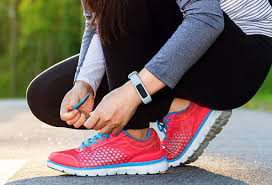
Along with the start of the new year comes that familiar trigger to once again to give your health and well being a new start or an upgrade. But before you jump into whatever exercise routine or activity you decide, your footwear and foot care should be the primary consideration to avoid pain, and achieve your best results overall.
Let’s start with basics. Whether inside or in the beautiful outdoors, jogging, running, and walking are among the purest, most natural forms of exercise we can do. On top of that, across all spectrums of athletic endeavors, from lifting weights to playing tennis, all require healthy feet and good foot gear. They go hand in hand.
Choose the wrong athletic shoes and you could end up lying on the couch nursing shin splints or aching heels instead of enjoying a brisk walk or run.
While most specialty sport-shoe stores have knowledgeable staff to guide you, you’ll be a few steps ahead of the game armed with some basic knowledge about your feet and their specific needs. Here is some expert advice to heed before buying new footwear:
- Don’t make shoes multitask
Walking shoes are stiffer; running shoes are more flexible, with extra cushioning to handle greater impact. If you do both activities, get a pair for each one
2. Know your foot
Sure, we’ve all got 10 toes and two heels, but beyond that, feet come in a variety of shapes — and knowing your foot’s particular quirks is key to selecting the right pair of shoes. Most major brands now offer a model to suit every foot type.
One way to determine your foot’s shape is to do a “wet test”— wet your foot, step on a piece of brown paper and trace your footprint. Or just look at where your last pair of shoes shows the most wear.
If your footprint shows the entire sole of your foot with little to no curve on the inside — or if your shoes show the most wear on the inside edge — it means you’ve got low arches or flat feet and tend toward overpronation — meaning your feet roll inward. Overpronation can create extra wear on the outside heel and inside forefoot. You’ll want a shoe with a motion-control feature and maximum support.
If you have high arches and tend to underpronate (also called supinate), your feet roll outward. Underpronation causes wear on the outer edge of the heel and the little toe. Look for a cushioned shoe with a soft midsole.
You have a neutral arch if your footprint has a distinct curve along the inside and your shoes wear out uniformly. Look for a “stability” shoe, which has the right mix of cushioning and support.
The easiest way to know your foot type is to ask the one of the doctors at Lambton Chiropractic! We would be happy to offer assistance.
- Measure your foot frequently
“It’s a myth that foot size doesn’t change in adults,” says Steven Raiken, MD. “It does change as we get older, so have your feet measured twice a year. Sizes also vary between brands, so go by what fits, not by what size the shoe is.” Raiken is director of the foot and ankle service at the Rothman Institute at Thomas Jefferson University Hospital in Philadelphia.
- Shop toward the end of the day
Feet swell over the course of the day; they also expand while you run or walk, so shoes should fit your feet when they’re at their largest.
- Bring your own socks
When you go to the store bring the same socks you wear while running or walking. If you use othotics, bring those, too. Shoes need to fit with the orthotic inside.
- Don’t believe in the need to “break in”
Running and walking shoes should feel comfortable right away. Walk or run around the store a bit to make sure they feel good in action.
- Use the rule of thumb
There should be about 3/8-1/2 inch between the front of your big toe and the end of the shoe — about a thumb’s width. The heel should fit relatively tightly; your heel should not slip out when you walk. The upper part of the shoe — which goes over the top of your foot — should be snug and secure, and not too tight anywhere. The American Academy of Orthopaedic Surgeons writes that when fitting in to an athletic shoe you should be able to freely wiggly all of your toes when the shoe is on.
- Understand the bells and whistles
Some models of running shoes look better suited to a space mission than a run in the park, but some of those groovy-looking features actually serve a purpose. Clear inserts, filled with gel, Freon, or air, provide extra shock absorption, as do those springy-looking things. These features are especially good for people who tend to get heel pain, says Raiken, and not so good for people whose ankles twist easily, as shoes with extra cushioning tend to provide less traction.
- Don’t over- or underpay
Good-quality running and walking shoes are fairly pricey — and usually worth it. “A $30-shoe will not be as good as an $90-shoe,” says Raiken. But you’ll pay a premium for super-fashionable styles or those associated with a celebrity — and they won’t be any better for your feet.
- Know when to replace them
The average pair of running shoes should be replaced after about 350-400 miles of use, says Clifford Jeng, MD, a foot and ankle surgeon at Mercy Medical Center in Baltimore, Md. Better yet, go by how your shoes look and feel. Once the back of the sole is worn out or the shoe feels uncomfortable or less supportive, it’s time to take those tootsies shopping again.
